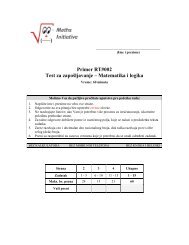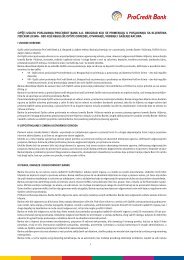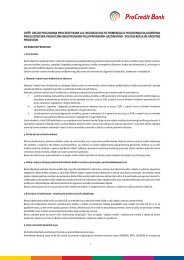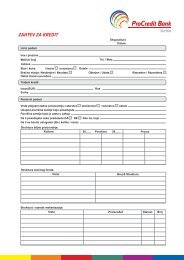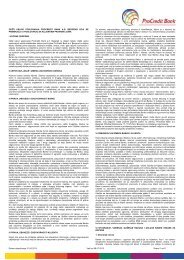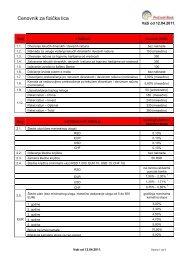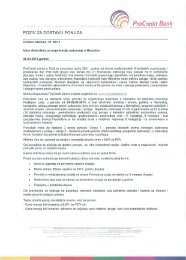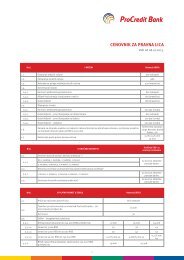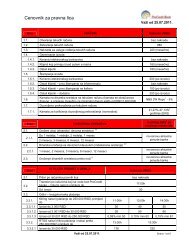Annual Report 2010 - ProCredit Bank
Annual Report 2010 - ProCredit Bank
Annual Report 2010 - ProCredit Bank
- No tags were found...
You also want an ePaper? Increase the reach of your titles
YUMPU automatically turns print PDFs into web optimized ePapers that Google loves.
52<br />
<strong>Annual</strong> <strong>Report</strong> <strong>2010</strong><br />
Classes of financial assets<br />
The Group classifies the financial instruments into classes that reflect<br />
the nature of information and take into account the characteristics<br />
of those financial instruments. The classification made can<br />
be seen in the table below:<br />
Category of financial assets per IAS39 Class determined by the <strong>Bank</strong> Subclass<br />
Financial assets at fair value through profit and loss Derivative financial assets Derivatives – non-hedging<br />
Loans and receivables Loans and advances to banks <strong>Bank</strong>s within the Group<br />
Loans and receivables Loans and advances to banks OECD banks<br />
Loans and receivables Loans and advances to banks Domestic and non-OECD banks<br />
Loans and receivables Loans and advances to customers Business<br />
Loans and receivables Loans and advances to customers Agricultural<br />
Loans and receivables Loans and advances to customers Housing<br />
Loans and receivables Loans and advances to customers Finance leases<br />
Loans and receivables Loans and advances to customers Consumer<br />
Loans and receivables Loans and advances to customers Other<br />
Available for sale financial assets Available for sale financial assets Listed<br />
Available for sale financial assets Other financial instruments Unlisted<br />
(a) Financial assets at fair value through profit or loss<br />
(b) Loans and receivables<br />
This category has two sub-categories: financial assets held for<br />
trading, and those designated at fair value through profit or loss<br />
at inception.<br />
A financial asset is classified as held for trading if it is acquired<br />
or incurred principally for the purpose of selling or repurchasing<br />
in the near term or if it is part of a portfolio of identified financial<br />
instruments that are managed together and for which there is evidence<br />
of a recent actual pattern of short-term profit-taking. Derivatives<br />
are also categorized as held for trading unless they are designated<br />
as hedging instruments.<br />
Loans and receivables are non-derivative financial assets with<br />
fixed or determinable payments that are not quoted in an active<br />
market. All loans and advances are initially recognized at fair value.<br />
All loans and advances are recognized when cash is advanced to<br />
borrowers. After initial recognition, these are subsequently measured<br />
at amortized costs using the effective interest rate method.<br />
Amortized cost is calculated by taking into account any issue costs<br />
and any discount or premium on settlement.<br />
(c) Held-to-maturity financial assets<br />
Financial assets and financial liabilities are designated at fair value<br />
through profit or loss when:<br />
• Doing so significantly reduces measurement inconsistencies<br />
that would arise if the related derivatives were treated as held<br />
for trading and the underlying financial instruments were carried<br />
at amortized cost for loans and advances to customers or<br />
banks and debt securities in issue’<br />
• Certain investments, such as equity investments, are managed<br />
and evaluated on a fair value basis in accordance with<br />
a documented risk management or investment strategy and<br />
reported to key management personnel on that basis are designated<br />
at fair value through profit and loss; and<br />
• Financial instruments, such as debt securities held, containing<br />
one or more embedded derivatives significantly modify the<br />
cash flows, are designated at fair value through profit and loss.<br />
Gains and losses arising from changes in fair value are included<br />
directly in the consolidated income statement and are reported as<br />
‘Net trading income’. Interest income and expense and dividend<br />
income and expenses on financial assets held for trading are included<br />
in ‘Net interest income’ or ‘Dividend income’, respectively.<br />
Gains and losses arising from changes in the fair value of derivatives<br />
that are managed in conjunction with designated financial assets<br />
or financial liabilities are included in “Net result from financial<br />
assets through profit and loss”.<br />
Held-to-maturity investments are non-derivative financial assets<br />
with fixed or determinable payments and fixed maturities that the<br />
Group’s management has the positive intention and ability to hold<br />
to maturity. If the Group were to sell other than an insignificant<br />
amount of held-to-maturity assets, the entire category would be<br />
reclassified as available for sale. The Group did not classify any financial<br />
asset as held-to-maturity during reporting period.<br />
(d) Available-for-sale financial assets<br />
Available-for-sale investments are those intended to be held for<br />
an indefinite period of time, which may be sold in response to<br />
needs for liquidity or changes in interest rates, exchange rates or<br />
equity prices.<br />
Regular-way purchases and sales of financial assets at fair value<br />
through profit or loss, held to maturity and available for sale are<br />
recognized on trade-date – the date on which the Group commits to<br />
purchase or sell the asset.<br />
Financial assets are initially recognized at fair value plus transaction<br />
costs for all financial assets not carried at fair value through<br />
profit or loss. Financial assets carried at fair value through profit<br />
or loss are initially recognized at fair value and transaction costs<br />
are expensed in the income statement. Available-for-sale financial<br />
assets and financial assets at fair value through profit or loss are<br />
subsequently carried at fair value. Loans and receivables and heldto-maturity<br />
investments are carried at amortized cost using the effective<br />
interest method.



